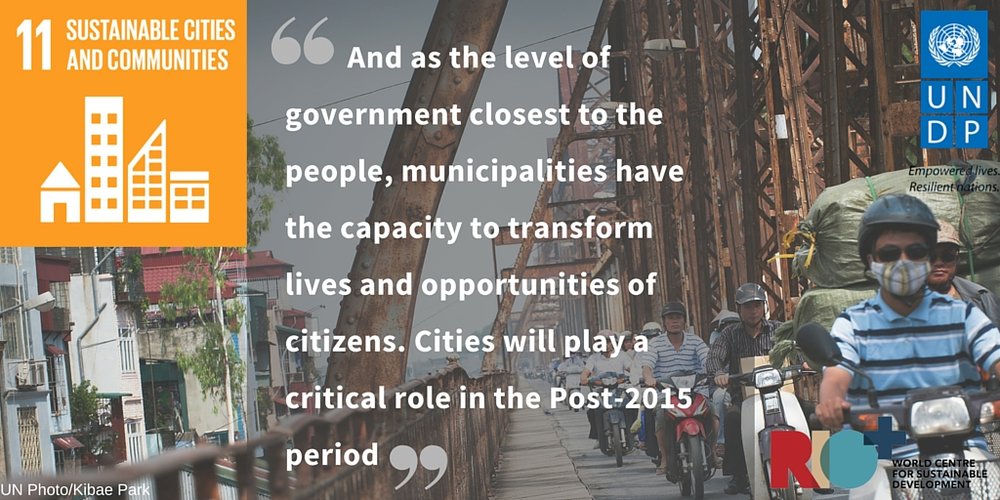
Are you committed to fighting climate change but worry that your city life is the antithesis of green living? Take heart–there are several important ways you can help protect the planet *and* your city.
A version of this article was originally published by Sustaining Life for the UNDP.
You may think that because you live in an urban area, there isn’t much that you as an individual can do about climate change. After all, you want to live in a city, not on a farm and therefore can’t realistically go off the grid. What if I told you that there’s no need for such drastic measures? There are simple, reasonably easy actions that all urbanites can take in order to pitch in their part in reversing the disastrous effects of climate change. In fact, living in a densely populated urban area might even put you at an advantage for being more climate friendly when it comes to the resources, technology, and civic support that is available only within a city.
According to the United Nations Development Programme, cities are at the forefront of climate change with growing populations and massive usage of energy and natural resources. Though cities occupy only 3% of our planet, they produce over 70% of the world’s greenhouse gas emissions and consume 80% of the world’s energy supply. This means that if cities can run off 100% renewable energy, the impact of changing just that small percentage of our planet will be enormous. So if you live in an urban area, there is some sort of responsibility even, to push your city to change its policies to energy efficient, eco-friendly alternatives.
On the flipside of this positive, unique ability for a city to make a huge impact is the fact that the same cities are at greater risk of being affected by climate change. About 75% of large cities around the globe are located on the coast and will be directly affected by the rise in sea level that is already guaranteed to happen, even if we cap the increase in global temperature at 2°C or below. Even worse, when disasters hit cities, the effects are felt on a large scale, disrupting economies, civic infrastructure, and healthcare systems. Cities like New York, Bangkok, Vancouver, Manila, and so many others are increasingly at risk of being hit by superstorms and hurricanes along with a gradual–yet drastic–rise in sea level.
So along with being at an advantage and being responsible for making sustainable changes in your city, you and your city may eventually be forced to do so. But we’d rather not wait until that point–instead, all of us urbanites can take action to ensure that our cities will not only survive climate change but also lead the way in combatting it. In any large city, there are a million little things that one person can do to reverse climate change by living a sustainable lifestyle. Even better, you already know that your actions won’t be isolated or alone. For example, in 2014, over 400,000 people came out to New York to join the People’s Climate March and demand that action be taken against climate change. You, a city dweller, can take actions both large and small to do the same. Below are just four ideas.

1. Cut Carbon Emissions: Walk, Bike, Ride.
Let’s be real here; you didn’t move to a large city to drive a car. You came here to become a part of this mass of living, thriving energy, and there’s no better way to do that than to travel the city streets. Walking the city streets on a nice day is the best feeling in the world–you never know who you’ll meet or what you might discover. Instead of driving to brunch, take a walk, and see your neighborhood like never before. Or hop on a bicycle, and you’ll find that two wheels can be a lot faster than four. If you live in New York, you can take advantage of the easy-to-use Citibikes docks all over Manhattan–there’s even an ever-growing cohort in Brooklyn. CitiBike is an affordable, healthy, and incredibly efficient way to get around town.
Even if the weather is less than ideal, or you just don’t have the energy to walk or bike, most large cities have an efficient subway or bus system that will get you anywhere you need to go. When divided among the thousands of people taking those trains and buses each day, the carbon footprint of riding the subway in a big city is satisfyingly low.

2. Support Your Local Businesses.
We city dwellers can tend towards extreme laziness, refusing to walk farther than a block or two to grab a snack, a drink, or our daily necessities. Incredibly, this attitude has allowed many large cities to retain a lot of their local businesses. Instead of taking that midnight walk to a Duane Reade or CVS, try the local bodega on the corner and put your money in the pocket of someone who lives here and cares about what happens in the city. Instead of taking the subway or a taxi uptown to shop the big box department stores, try checking out the tiny little boutiques around the corner, whose smaller spaces and even smaller inventories require much less carbon output to get into your hands.
Even better, forgo a trip to Whole Foods, Fairway, or Food Bazaar and check out the local farmers market instead. For example, New York City’s Greenmarkets can be found in over 50 locations on any day of the week, with New York State, Connecticut, New Jersey, and Philadelphia farms all robustly represented. Pay attention to the seasonality of different foods and know that when you buy a tomato in mid-August that traveled to your plate from 50 miles away on Long Island, the carbon footprint is significantly lower than the mid-January tomato traveling from California, over 3,000 miles away. Even better, when you support farmers that inhabit the same 300-mile radius as you, you are simultaneously supporting healthy soil, clean water, and clean air in your immediate environment.

3. (Rethink) Reduce, Reuse, Recycle.
While our own personal waste may not seem like so much, when you see trash bags piled on every curb in the city, you realize just how much your city sends to the landfill. Trash might not seem like the biggest problem where you live, but overflowing landfills are actually a huge stress to our environment. In addition to ensnaring and strangling marine life around the world, trash sitting in landfills can leach toxins into groundwater while discarded items decompose and emit methane, a powerful greenhouse gas which, according to the EPA, makes up about 11% of global emissions each year.
While you may not be able to attain zero waste status, you can drastically cut down on your overall waste. Reconsider purchasing a single-use item or one that comes wrapped in layers of plastic. Refuse plastic bags, opting instead for reusable ones. Try carrying around a reusable water bottle rather than spending money on water in a plastic bottle. Small actions like these can really add up, especially if every person makes a point to stick to them. Some actions that require more than minimal effort, but are completely reasonable, can have an even bigger effect. Composting is one way to dramatically reduce the waste your household or office sends to the landfill, and cities are taking steps to make the process a lot easier. If you live in New York, see if your neighborhood has one of over 50 food scrap drop-off sites, or take your bag to the Greenmarket when you go to buy your locally grown vegetables. New York City businesses can even contact companies like Common Grounds Compost or BK Rot to establish a composting program at the office. Take an extra step and cut down on your household’s textile waste by donating clothing to Housing Works’ ReFashioNYC instead of tossing old garments in the trash.

4. Get Active, Get Involved.
You can do this anywhere, but voting and advocating for political changes at the city level can make a big difference in your urban center. Educate yourself on city policies and understand who the local politicians are. While politics may seem like too big or complicated of a beast to get involved in, it is the best way to advocate for tangible change in the US.
Check out your city’s plans for combatting climate change in the long run. In New York, for example, there’s the 0X30 initiative and PlaNYC. Pay attention to and advocate for laws like the bans on styrofoam or plastic bags by writing to your City Council Member. Getting involved with local activist groups and environmentally focused events can be a great way to learn more about what’s happening in your area and to speak up with your fellow city dwellers to push the city ever forward on climate change.

As an urbanite, you have so many tools and resources at your fingertips to combat climate change, and as someone who lives in a large city, you have the unique opportunity to actually experience the change that you advocate for. With threats of sea level rise and climate-related disasters close at hand, cities and their inhabitants have already risen to the challenge of reversing climate change, all you have to do is make a few small changes, one or two big ones, and pay attention to the politics and policies of your city. Like other cities around the world, New York City’s plan of action in the coming years will shape the way the city looks in the next decade, the next century. Take advantage of your city’s resources and the existing movement and add your voice to the city’s fight against climate change.
Information for this article was provided by the United Nations Development Programme. Find out how UNDP is taking action on climate change here.
__
What steps are you taking to fight climate change in your city?
Also by Faye: Pear Apple Tarte
Related: How Composting Helps the Environment–In Numbers
Genius Home Hacks that Save Water–and $$$
Get more like this—Subscribe to our daily inspirational newsletter for exclusive content!
__
Photos: UNDP, Sustaining Life




